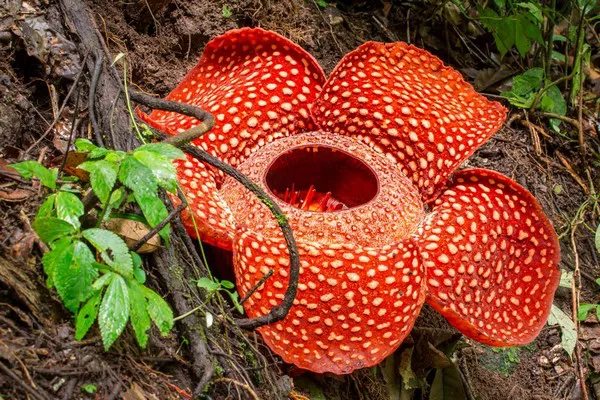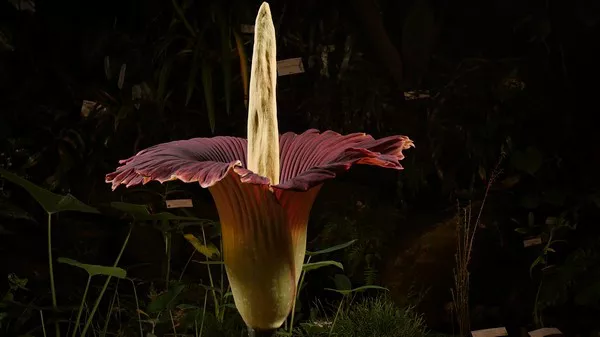Nature is full of wonders, and among them are the extraordinary flowers that capture our fascination due to their size, appearance, and sometimes, their smell. Among these botanical marvels, the Rafflesia arnoldii and the Amorphophallus titanum, commonly known as the corpse flower, stand out. This article delves into the intriguing world of these two unique flowers, exploring their characteristics, habitats, reproductive strategies, and the scientific significance behind their notorious odors.
1. Rafflesia Arnoldii: The Giant of the Rainforest

Overview
Rafflesia arnoldii, often referred to as the “corpse flower” due to its pungent odor, is recognized as the largest individual flower on Earth. Native to the rainforests of Southeast Asia, particularly Indonesia, Malaysia, and the Philippines, this flower can grow up to three feet in diameter and weigh up to 15 pounds.
Morphological Features
Rafflesia arnoldii lacks leaves, stems, and roots, making it a true botanical enigma. It is a parasitic plant, relying entirely on its host, usually a vine from the genus Tetrastigma, for water and nutrients. The flower is characterized by its reddish-brown petal-like structures called perigone lobes, which are covered in white, wart-like spots. At the center of the flower is a spiked, central disk, surrounded by a large, bowl-shaped diaphragm.
Habitat and Distribution
Rafflesia arnoldii thrives in the lowland rainforests of Southeast Asia. These forests provide the warm, humid conditions necessary for its growth. The flower is typically found in undisturbed, primary forests, where it parasitizes specific host vines. Conservation efforts are crucial as habitat loss poses a significant threat to this already rare species.
Life Cycle and Reproduction
The life cycle of Rafflesia arnoldii is as fascinating as its appearance. The plant begins as a tiny bud growing within the tissue of its host vine. It can take several months for the bud to develop into a mature flower. Once it blooms, the flower emits a strong odor reminiscent of decaying flesh, attracting carrion flies and beetles, which act as pollinators. The bloom lasts only a few days before it begins to decompose.
The Stench Factor
The infamous smell of Rafflesia arnoldii is a key adaptation for pollination. The odor, caused by compounds such as dimethyl disulfide and dimethyl trisulfide, mimics the scent of rotting meat, drawing in scavenging insects that facilitate pollination. This unique strategy ensures the plant’s reproduction in its dense, competitive forest habitat.
Conservation Status
Rafflesia arnoldii is classified as vulnerable due to its limited distribution and the destruction of its rainforest habitat. Conservation efforts focus on protecting its natural environment and studying its complex biology to ensure its survival.
See Also: Top 10 Most Weird Plants in the World
2. Amorphophallus Titanum: The Titan Arum

Overview
Amorphophallus titanum, commonly known as the “Titan Arum” or “corpse flower,” holds the record for the largest unbranched inflorescence in the plant kingdom. Native to the equatorial rainforests of Sumatra, Indonesia, this plant can reach heights of up to 12 feet when in bloom.
Morphological Features
The Titan Arum consists of a massive underground corm, from which a single, enormous inflorescence emerges. The inflorescence is composed of a central spadix, which can grow up to 10 feet tall, surrounded by a petal-like spathe that opens to reveal the spadix. The spathe is green on the outside and deep red on the inside, mimicking the appearance of rotting flesh.
Habitat and Distribution
Amorphophallus titanum thrives in the tropical rainforests of Sumatra, where it grows in rich, well-drained soil. It is typically found in the understorey of the forest, where it benefits from the warm, humid conditions and filtered sunlight.
Life Cycle and Reproduction
The life cycle of the Titan Arum is marked by long periods of dormancy, followed by dramatic blooms. The plant can remain dormant for several years, during which time it stores energy in its corm. When conditions are favorable, the plant produces a single, massive inflorescence. The bloom emits a powerful odor of decaying flesh, attracting carrion beetles and flesh flies that act as pollinators. The bloom lasts for only 24 to 48 hours before collapsing.
The Stench Factor
Similar to Rafflesia arnoldii, the Titan Arum’s smell is an adaptation for attracting pollinators. The spadix heats up during blooming, helping to volatilize the compounds responsible for the odor, such as putrescine and cadaverine. This creates a more intense scent that can travel longer distances, effectively luring pollinators.
Conservation Status
Amorphophallus titanum is considered endangered due to habitat loss and deforestation in Sumatra. Botanical gardens and research institutions around the world cultivate the plant, contributing to conservation efforts and public awareness of its plight.
The Science Behind the Smell
Chemical Composition
The odors of both Rafflesia arnoldii and Amorphophallus titanum are produced by a complex mixture of volatile organic compounds. Key compounds include dimethyl disulfide, dimethyl trisulfide, putrescine, and cadaverine, all of which are associated with the smell of decomposing organic matter. These compounds are synthesized by specialized cells in the flowers and released into the air to attract pollinators.
Pollination Strategy
The evolution of carrion mimicry in these flowers is a fascinating example of adaptation. By mimicking the smell of rotting meat, these plants exploit the foraging behavior of carrion-feeding insects. The strong odor, combined with visual and thermal cues, creates an irresistible lure for pollinators. Once inside the flower, insects become coated with pollen, which they then transfer to other flowers, facilitating cross-pollination.
Ecological Significance
The unique pollination strategies of Rafflesia arnoldii and Amorphophallus titanum highlight the intricate relationships between plants and their pollinators. These interactions are crucial for the reproduction of these species and the maintenance of biodiversity in their native habitats. Understanding these relationships helps scientists develop conservation strategies to protect these remarkable plants and their ecosystems.
Cultural and Scientific Impact
Historical Significance
Rafflesia arnoldii was first discovered in 1818 by Sir Stamford Raffles and Dr. Joseph Arnold during an expedition in Sumatra. The Titan Arum was described by Italian botanist Odoardo Beccari in 1878. Both discoveries captivated the scientific community and the public, sparking interest in the unique flora of the tropics.
Modern Research
Today, both Rafflesia arnoldii and Amorphophallus titanum continue to be subjects of scientific study. Researchers investigate their complex life cycles, pollination mechanisms, and genetic makeup. Studies on these plants contribute to our understanding of parasitic and large-flowering plant biology, as well as conservation science.
Public Fascination
The dramatic size and odor of these flowers have made them popular attractions in botanical gardens worldwide. When a Titan Arum blooms, it often attracts large crowds eager to witness and smell this rare event. Such public displays raise awareness about the importance of plant conservation and the fascinating diversity of the plant kingdom.
Conservation Efforts
Habitat Protection
Protecting the natural habitats of Rafflesia arnoldii and Amorphophallus titanum is crucial for their survival. Conservation organizations work to preserve rainforests in Southeast Asia, combat deforestation, and promote sustainable land use practices.
Ex Situ Conservation
Botanical gardens and research institutions play a vital role in conserving these species through ex situ conservation. By cultivating and studying these plants outside their natural habitats, scientists can ensure their survival and develop strategies for reintroduction into the wild.
Education and Advocacy
Educating the public about the ecological importance and conservation needs of these plants is essential. Public engagement through exhibitions, educational programs, and media coverage helps build support for conservation initiatives and fosters a deeper appreciation for the natural world.
See Also: 5 Biggest Anthurium Species (Plus Pictures!)
Conclusion
The Rafflesia arnoldii and Amorphophallus titanum are remarkable examples of nature’s ingenuity and diversity. Their immense size, unique morphology, and powerful odors make them stand out in the plant kingdom. While their stench might be off-putting to humans, it serves a vital purpose in their pollination strategies, ensuring their survival in the dense rainforests of Southeast Asia. Protecting these extraordinary plants and their habitats is crucial for preserving the rich biodiversity of our planet. Through continued research, conservation efforts, and public education, we can ensure that future generations will have the opportunity to marvel at these botanical wonders.
You Might Be Interested In:

























